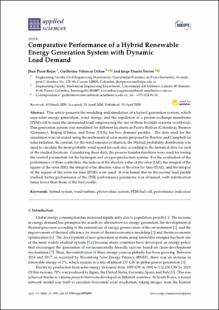Comparative Performance of a Hybrid Renewable Energy Generation System with Dynamic Load Demand
Artículo de revista
2020-04-29
Applied Sciences
Berna , Suiza
This article presents the modeling and simulation of a hybrid generation system, which uses solar energy generation, wind energy, and the regulation of a proton exchange membrane (PEM) cell to raise the demanded load, empowering the use of these hydride systems worldwide. This generation system was simulated for different locations in Puerto Bolivar (Colombia), Bremen (Germany), Beijing (China), and Texas (USA), for two demand profiles. The data used for the simulation was calculated using the mathematical solar model proposed by Beistow and Campbell for solar radiation. In contrast, for the wind resource evaluation, the Weibull probability distribution was used to calculate the most probable wind speed for each day, according to the historical data for each of the studied locations. Considering these data, the process transfer functions were used for tuning the control parameters for the hydrogen and oxygen production system. For the evaluation of the performance of these controllers, the indices of the absolute value of the error (IAE), the integral of the square of the error (ISE), the integral of the absolute value of the error for time (ITAE), and the integral of the square of the error for time (ITSE) were used. It was found that in the second load profile studied, better performance of the ITSE performance parameter was obtained, with stabilization times lower than those of the first profile
- EULER [81]
Descripción:
Comparative Performance of a Hybrid Renewable Energy Generation System with Dynamic Load Demand.pdf
Título: Comparative Performance of a Hybrid Renewable Energy Generation System with Dynamic Load Demand.pdf
Tamaño: 10.26Mb
 PDF
PDF
 LEER EN FLIP
LEER EN FLIP
Título: Comparative Performance of a Hybrid Renewable Energy Generation System with Dynamic Load Demand.pdf
Tamaño: 10.26Mb
 PDF
PDF
 LEER EN FLIP
LEER EN FLIP
















